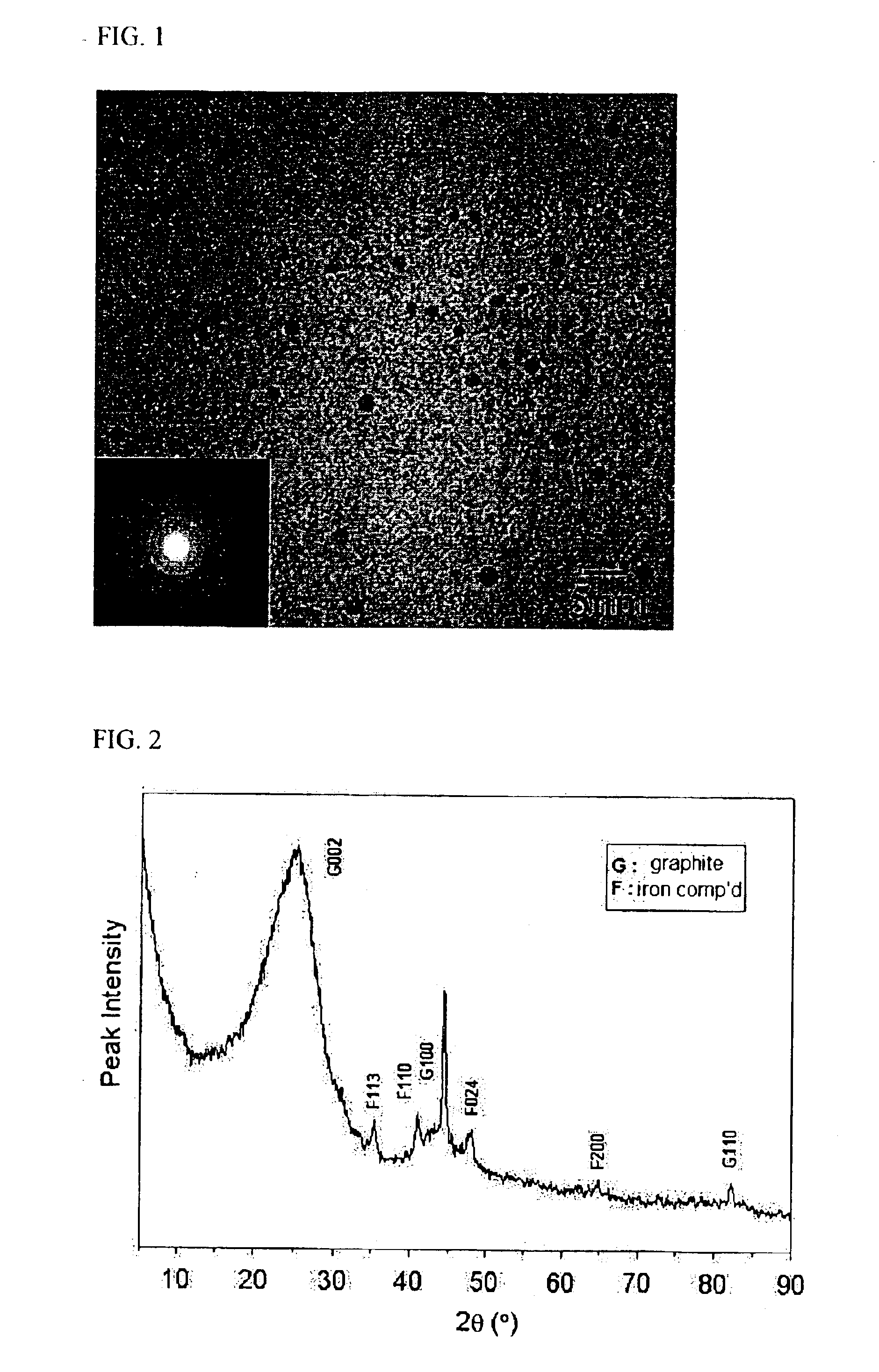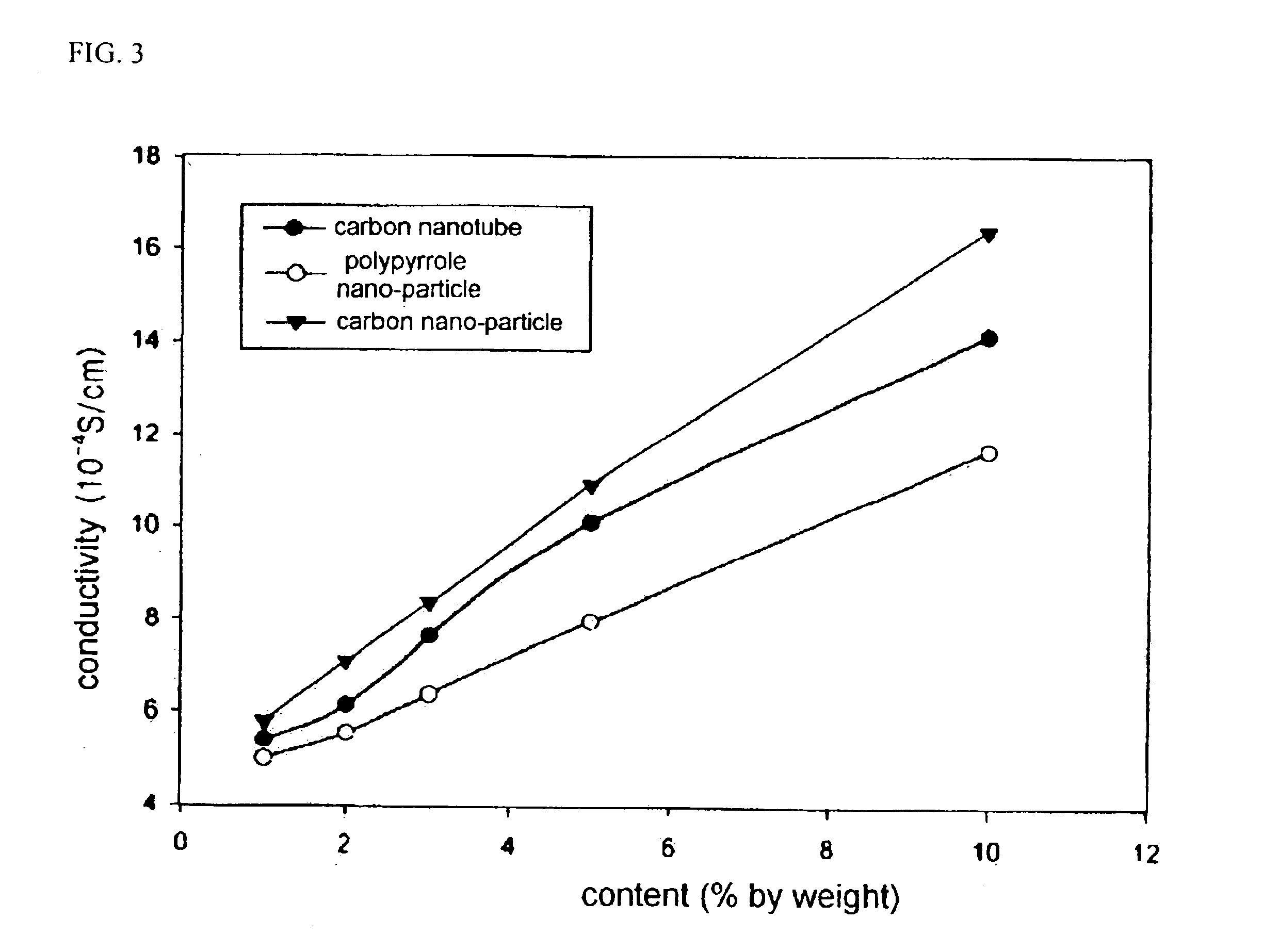Carbon nano-particle and method of preparing the same and transparent conductive polymer composite containing the same
- Summary
- Abstract
- Description
- Claims
- Application Information
AI Technical Summary
Benefits of technology
Problems solved by technology
Method used
Image
Examples
example 1
[0061]About 80 ml of distilled water was poured in a reactor of 1 L installed in a thermostat bath set to 25° C. Thereafter, 6 g of decyltrimethylammonium bromide (DTAB) was added and then agitated at the rate of about 400 rpm to form micells. 2 g of pyrrole monomers were slowly dropped in the reactor using a pipette. 11.12 g of FeCl3 (the mole rate of pyrrole / FeCl3=1 / 2.3) were dissolved in 10 ml of distilled water and then the thusly obtained solution was added into the reactor. After agitation for about 4 hours at 25° C., about 500 ml of methanol was added into the reactor to destroy the micells. The reaction solution was moved into a separatory funnel, and then the separatory funnel was smoothly shaken a few times to help blending of the solution. In order to increase the separation rate of the synthesized polymer nano-particle (polypyrrole nano-particle), about 100 ml of iso-octane was added as a non-solvent into the separatory funnel. The upper layer of iso-octane and methanol ...
example 2
[0063]1% by weight, 3% by weight and 10% by weight of the carbon nano-particles with the mean particle diameter of 2 nm, prepared in the example 1, were solution-blended into polycarbonate (average molecule weight: 13,800), respectively. Then, the blend was spin-coated on a cover glass by the thickness of 270 nm (measured by alpha step method) to prepare a film. Tetrahydrofurane (THF) was used as a solvent for the solution blending. For comparison therewith, the non-carbonizing polymer nano-particle (polypyrrole nano-particle), which was not undergone the carbonization process in the Example 1, and the carbon nanotube (from Aldrich company) were respectively solution-blended with polycarbonate to prepare films was measured with UV / VIS spectrophotometer in a visible ray region. Table 1 (below) shows the average of transmittancy based on the wavelength. As shown in Table 1, the carbon nano-particle has a higher average transmittancy than carbon nanotubes. For example, in addition of 1...
example 3
[0065]Specimens were prepared in the same manner as Example 2 except that the polymers nano-particle (polypyrrole nano-particle) and carbon nano-particles and carbon nanotubes were respectively added at 1% by weight, 2% by weight, 3% by weight, 5% by weight, and 10% by weight to make them the pellet shape. The electrical conductivity of the specimens was measured according to the Van der Pauw method. The results of the above measurement are shown in FIG. 3. As shown in FIG. 3, the PC specimens containing the carbon nano-particles according to the present invention had the higher conductivity than any others. For example, in addition of 10% by weight, the PC specimen containing the carbon nano-particle has the electrical conductivity of 16×10−4 s / cm, which shows that the PC specimen containing the carbon nano-particle according to the present invention has the significantly high conductivity, compared to the PC specimen containing the carbon nanotube which has the conductivity of 14×...
PUM
| Property | Measurement | Unit |
|---|---|---|
| Temperature | aaaaa | aaaaa |
| Temperature | aaaaa | aaaaa |
| Temperature | aaaaa | aaaaa |
Abstract
Description
Claims
Application Information
 Login to View More
Login to View More - R&D
- Intellectual Property
- Life Sciences
- Materials
- Tech Scout
- Unparalleled Data Quality
- Higher Quality Content
- 60% Fewer Hallucinations
Browse by: Latest US Patents, China's latest patents, Technical Efficacy Thesaurus, Application Domain, Technology Topic, Popular Technical Reports.
© 2025 PatSnap. All rights reserved.Legal|Privacy policy|Modern Slavery Act Transparency Statement|Sitemap|About US| Contact US: help@patsnap.com



